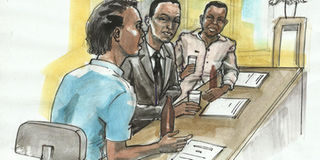Miscarriage of justice

Three people were convicted of the murder of Daniel Karuhanga and five of his workers on the night of Friday August 16, 2013 in Kiruhura District.
The crucial piece of evidence that court relied on to convict the three men was a charge and caution statement purportedly made by one of the convicted men, who however, retracted the statement.
Conflict
Further, court treated the statement as a confession. The statement did not match the account given by eye witnesses.
The law is clear on this; in a criminal trial it is unsafe to rely on the evidence of an accomplice unless it is independently corroborated. There was no independent corroboration in this case as shown by the following facts;
• Eye-witnesses reported seeing only one assailant. In the statement there were more than four assailants.
• The student who was sexually violated stated that the incidence occurred in her grandfather’s car. But in the statement the perpetrator of the offence reported that he committed the offence when the girl was leaning against a vehicle they had travelled in. And when the police attempted to reconstruct the events of that night the assailant told them that he committed the sexual assault in the field.
• The identification of the assailant could not have been said to be beyond reasonable doubt; a key witness stated “I am not sure whether I saw him that time, but he resembles the one I saw the day of the incident. I did not see him again until today.” This witness however failed to identify the suspected assailant in several identification parades.
• The testimony of other eye witnesses clearly shows that none of the accused persons was positively identified at the time of the commission of the offence. To court there was no direct evidence linking any of the accused with the offences.
• The key witness also heard one of the workers who was eventually killed saying “Kamudani why are you killing me?” Court considered this a dying declaration which unfortunately was not investigated to its logical conclusion. Court called this part of the investigation poor and unprofessional.
Contradictions
These obvious contradictions should have been resolved in favour of the accused as is the case in criminal trials. Why did court flout this cardinal rule?
Mattew Mugooha alias Juju, one of the three men convicted of the murders, told court that on the night in question he spent it at the home of his father-in-law who gave him two cows the following day. His wife testified that on August 16 and 17, she together with her husband was at her parent’s home.
Amon Twabagye alias Bujoro told court that on the dates in question he was assigned to ferry sand and bricks for a construction company in Ibanda District.
One of the workers of the construction company testified that on the dates in question he was with Twabagye and even told court that they shared the same mattress.
The witness told court “I used to be with Bujoro throughout the night from August 1 to September 4, 2013, Bujoro never left me in the night.”
The law is that an accused person who puts up a defence of alibi does not have the burden of proving it.
It is the duty of the prosecutor to prove the alibi to be a lie. But where the prosecution adduces evidence showing that the accused person was at the scene of crime, and the defence not only denies it, but also adduces evidence showing that the accused person was elsewhere at the material time, it is incumbent on court to evaluate both versions judiciously and give reasons why one and the other version is accepted. The prosecution failed to adduce independent evidence to prove both alibi lies.
Defining evidence
Physical evidence is defined as any material that can be used to link a suspect, a weapon or a scene to a crime. It includes biological and non-biological material and is scientific evidence which stands the test of time.
The importance of physical evidence in modern murder investigations cannot be overstated. However the investigators did not recover any physical evidence to link the convicted persons to the scene of crime or directly to the offence.
These were some of the lost opportunities;
• Vaginal swabs for DNA should have been carried out from rape victim to positively identify the assailant. There was no DNA evidence linking any of the accused to the scene of crime
• Finger prints should have recovered from the scene or the vehicles to link the accused persons to the scene
Telephone printouts do not show the exact location of the caller of the receiver of a call but will place either party within a radius. It is extremely dangerous to put somebody exactly at a scene of crime using this technology. This is however what court did in this case.
The investigators did not explain how one assailant could kill six adult men using a machete without any of them offering any resistance, save for one or two.
Could it be that the physical condition of the men were compromised? This may not be a farfetched idea when one considers that the assailant had an intimate and up to date knowledge of who slept where in Daniel Karuhanga’s home. Who provided the assailant with this information?
The recovery of the stolen family car or linking any of the accused persons with the stolen car would have been a gem in the investigations. Why did the investigators fail to recover this car?
And considering the profiles of the three people who were convicted, where they really capable of carrying out such horrific murders without leaving any trace of evidence? And what would be their motive? In truth was this not a gross miscarriage of justice?




